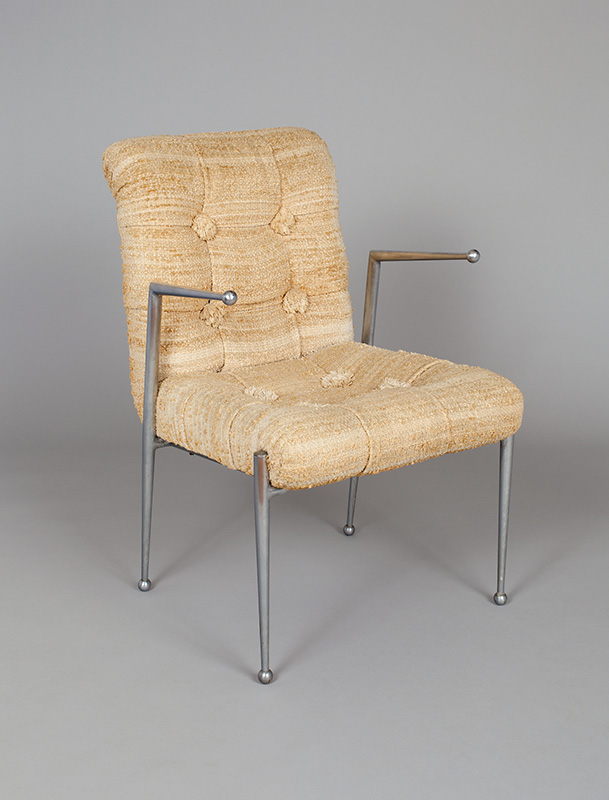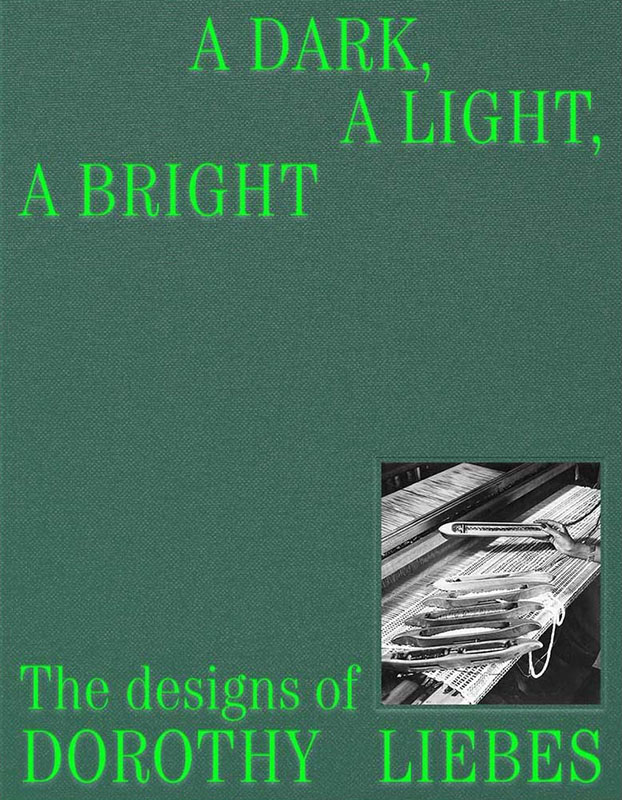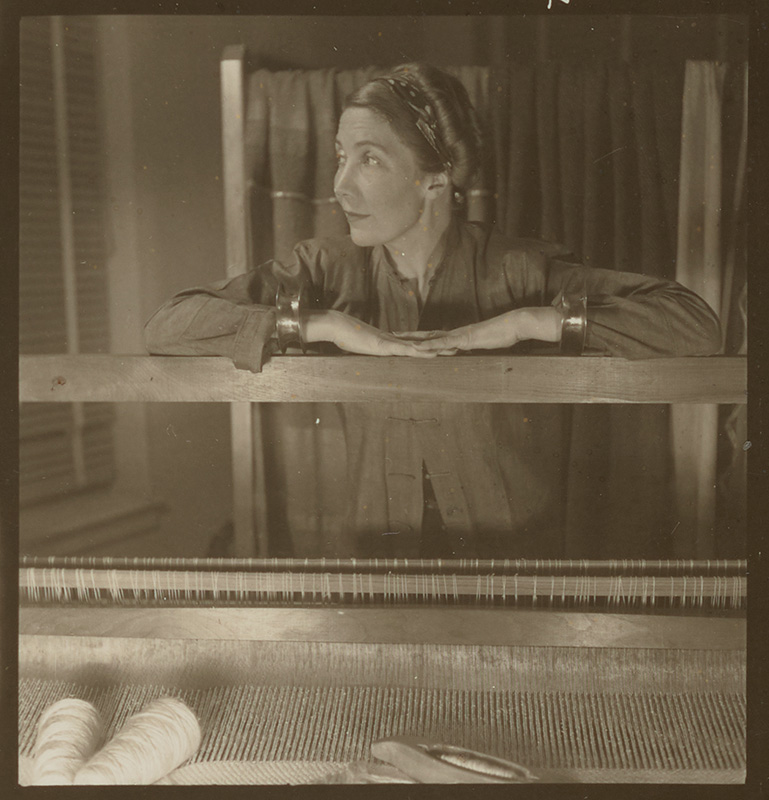A Dark, A Light, A Bright: A Long-Overdue Monograph on A Forgotten Titan of Modern Design
by Kate Burnett Budzyn
Mid-20th-century interior design is known for its cool, slick surfaces and crisp, low lines; its minimalist palette and expansive windows. But an equal part of the experience of Modernism is the sensory counterpoint offered by its textiles: nubbly upholstered seats provide comfort and textural play against cold chrome frames (figure 1); woven shades and curtains add color and pattern, modulate light, and afford privacy (figure 2).
Figure 1. Designed by Donald Deskey, Manufactured by Royal Metal Manufacturing Company, Upholstery designed by Dorothy Liebes, Armchair, 1938, Chicago, IL. Chrome-plated metal and upholstered fabric. Art Institute of Chicago, Gift of Mrs. Florene M. Schoenborn, 1970.1217.12. Photo courtesy The Art Institute of Chicago / Art Resource, NY.
The brilliant design force behind some of Midcentury Modernism’s most recognizable textiles was Dorothy Liebes, the subject of a new monograph published by Cooper Hewitt, Smithsonian Design Museum with Yale University Press (figure 3). Edited by Susan Brown and Alexa Griffith Winton, A Dark, A Light, A Bright is the first major publication devoted to Liebes. The book’s seven deeply researched essays buttress the exhibition by the same name that opened at Cooper Hewitt last month and effectively “reinstate Liebes as one of the most important designers of the twentieth century” (page 9 of A Dark, A Light, A Bright). This project was supported by the Decorative Arts Trust Prize for Excellence and Innovation.
Liebes was a weaver (figure 4). Following a formal education in applied arts and art education, she immersed herself in an independent study of textile history and production. She consulted and apprenticed with a wide range of specialists and became an avid handweaver. In the 1920s, she produced and showcased her work to a stylish circle of friends from within the San Francisco apartment she shared with her husband, but he forbade her from selling her weavings. As John Stuart Gordon recounts in his essay on Liebes’s contributions to the modern American interior, Liebes’s career began in earnest only after her marriage ended in 1930. Her distinctive textiles had already gained a reputation, however, and Liebes was able to start a custom textile business with quick success: she opened a studio, employed a team of weavers, and took on her first major project designing curtains for the San Francisco Stock Exchange Building.
Liebes became known for her use of exaggerated looped piles and yarns of different weights to create dramatic textural patterns in her weavings. She incorporated metallic fibers into her weaves to supplement her chromatic range—“metal is a color,” she reasoned—and to layer her fabrics’ multisensory striations with plays of light. This mixture of coarse textures and glittering highlights became so closely associated with the weaver-designer that it became known as “the Liebes look” (figure 5). Her work was sought-after by high-profile architects (Frank Lloyd Wright was a regular customer), decorators (Frances Elkins and Dorothy Draper were collaborators), and celebrities (Gary Cooper and Joan Crawford had her window treatments in their homes). One of Liebes’s most famous projects was for Henry Dreyfuss’s 1950 redesigning of the Persian Room nightclub at the Plaza Hotel (figure 2). To the spare, futuristic room she contributed brilliant green and blue metallic striped curtain panels (figure 6), throughout which her studio had woven, fantastically, tiny lightbulbs.
Figure 5. Designed by Dorothy Wright Liebes, Sample card, c. 1953. Plain-woven cellulose triacetate, viscose rayon, cotton, cellophane, Lurex (CAB-laminated aluminum yarn). Gift of the Estate of Dorothy Liebes Morin, Cooper Hewitt, Smithsonian Design Museum, 1972-75-88. Photo by Matt Flynn © Smithsonian Institution.
Figure 6. A decade after producing the originally handwoven curtains for the Persian Room, Liebes’s company provided an updated set made on power looms. Designed by Dorothy Liebes, Power-loomed drapery fabric for the Persian Room, Plaza Hotel, New York City, c. 1960. National Museum of American History, Smithsonian Institution, TE.T15564. Photo by Jaclyn Nash.
As Susan Brown explores in three short essays devoted to each of the salient formal features of the designer’s work, Liebes’s unique use of color, texture, and glitter introduced whimsy to even the most utilitarian of midcentury American textiles. Anointing her fabric designs with names like “mint julep,” “pretty penny,” and “gold-rush gingham,” Liebes wielded the kitschy poetry of her signature fiber combinations to great commercial success. She consulted for and had contracts with major industrial entities such as DuPont and American Airlines.
Despite becoming a prominent businessperson, Liebes remained a lifelong student, teacher, and practitioner of her craft. Even once most of her production had transitioned to machine looms, she insisted on maintaining a handweaving studio in New York, where she and her team of weavers could continue to experiment with colors and materials, using the practice of craft to work out design ideas. She traveled widely, forming international relationships with female weavers, and presented lecture series across the globe, as Emily M. Orr describes in her chapter, “Modern Weaving’s Global Ambassador.”
An essay by Leigh Wishner on Liebes’s influence on the fashion world will be of particular interest to scholars of dress. Liebes collaborated with major designers of the 1950s and 60s, most prominently Bonnie Cashin, and was responsible for popularizing one of the time period’s most successful fibers, Lurex, a plastic-laminated aluminum thread that did not tarnish, wore well, and therefore made sparkling garments an everyday prospect. Liebes’s own impeccable style spoke to her understanding of the indistinct boundary between clothing and other decorative arts. Her sartorial philosophy recommended the simple formula of “a light, a bright and a dark” in selecting tones of garments for an outfit. Liebes’s personal look and her studio’s posh, yarn-filled tableaux (figure 7) brought her frequent attention from women’s magazines and industry publications and helped define her brand.
The book pairs lush close-ups of weaving samples with archival images of interiors, thus bringing to life the full tonal force of her woven contributions to design, which often don’t come across in black-and-white images. Page after page of vibrant weave samples showcase an aesthetic that many will find deeply familiar in its nubbly, glittering contrasts, though few of us will have previously known whom to credit for its invention and cultural success. With A Dark, A Light, A Bright, we no longer have any excuse not to recognize “the Liebes look” wherever we encounter midcentury American textiles.
Kate Burnett Budzyn is a contributing writer for The Decorative Arts Trust Bulletin. She researches historic clothing and textiles and is the book review editor at Winterthur Portfolio.
About The Decorative Arts Trust Bulletin
Formerly known as the "blog,” the Bulletin features new research and scholarship, travelogues, book reviews, and museum and gallery exhibitions. The Bulletin complements The Magazine of the Decorative Arts Trust, our biannual members publication.
Click Images to Enlarge
Did you know that clicking on the images in Bulletin posts will allow you to get a closer look? Simply click on an image, and a larger version will open in a pop-up window.














